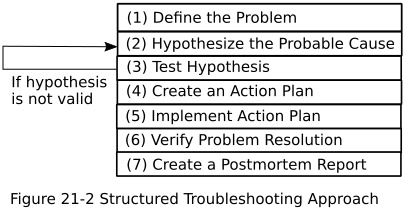Troubleshooting skills vary from administrator to administrator. Therefore, although most troubleshooting approaches include the collection and analysis of information, elimination of potential causes, hypothesis of likely causes, and testing of the suspected cause, different troubleshooters might spend different amounts of time performing these tasks.
If a troubleshooter does not follow a structured approach, the temptation is to move between troubleshooting tasks in a fairly random way, often based on instinct. Although such an approach might well lead to problem resolution, it can become confusing to remember what you have tried and what you have not tried. Also, if another administrator comes to assist you, communicating to that other administrator the steps you have already gone though could be challenging.
Therefore, following a structured troubleshooting approach not only helps prevent you from trying the same thing more than once and inadvertently skipping a task, but also aids in communicating to someone else the possibilities you have already eliminated.
You might encounter a variety of structured troubleshooting methodologies in networking literature. However, for the Network+ exam, the methodology shown in figure 21-2 is the one you should memorize.

The following is an elaboration of Step 1 of the seven-step methodology.
Step 1. Identify the problem. Effective troubleshooting begins with a clear problem definition. This definition might include specific symptoms. Here's an example. "User A's computer is unable to communicate with server 1 as verified by a ping test). However, user A can communicate with all other servers. Also, no other user seems to have an issue connecting to server 1.
This problem definition might come from questioning the impacted user(s) and doing your own testing (for example, seeing if you can ping from user A's computer to server 1). If possible, determine whether anything has changed in the network (or in the computer) configuration. Also, find out whether this is a new installation that has failed to work in the past.
Elaboration of Step 2 though Step 7 of the network troubleshooting methodology that should be understood and memorized for the Network+ exam can be found in CompTIA Network+ N10-008 Cert Guide
About The Author
Anthony Sequeira, CCIE No. 15626, is a Cisco Certified Systems Instructor (CCSI) and author regarding all levels and tracks of Cisco Certification. Anthony formally began his career in the information technology industry in 1994 with IBM in Tampa, Florida. He quickly formed his own computer consultancy, Computer Solutions, and then discovered his true passion-teaching and writing about Microsoft and Cisco technologies. Anthony joined Mastering Computers in 1996 and lectured to massive audiences around the world about the latest in computer technologies. Mastering Computers became the revolutionary online training company, KnowledgeNet, and Anthony trained there for many years. Anthony is currently pursuing his second CCIE in the area of Security and is a full-time instructor for the next-generation of KnowledgeNet, StormWind.com. Anthony is also a VMware Certified Professional.
CompTIA Network+ N10-008 Cert Guide contains proven study features that allow you to succeed on the exam the first time. Expert instructor Anthony Sequeira shares preparation hints and test-taking tips, helping you identify areas of weakness and improve both your conceptual knowledge and hands-on skills, essential for successful completion of the performance-based testing items on the exam. This complete, CompTIA-approved study package includes the following:
• A test-preparation routine proven to help you pass the exams
• Clearly defined chapter learning objectives covering all N10-008 exam topics
• Chapter-ending review questions and exam preparation exercises, which help you drill on key concepts you must know thoroughly
• The powerful Pearson Test Prep practice test software, complete with hundreds of well-reviewed, exam-realistic questions, customization options, and detailed performance reports
• 40 performance-based exercises to help you prepare for the hands-on exam questions
• A free copy of the CompTIA Network+ N10-008 Simulator Lite software, complete with meaningful lab exercises that enhance your hands-on skills
• More than 60 minutes of video mentoring
• A final preparation chapter that guides you through tools and resources to help you craft your review and test taking strategies
• An Exam Essentials appendix that quickly recaps all major chapter topics for easy reference, both in print and interactive digital format
• A key terms Glossary in both print and on the companion website, which acts as an interactive flash-card application
• Study plan suggestions and templates to help you organize and optimize your study time
• A 10% exam discount voucher (a $33+ value!)
Well regarded for its level of detail, study plans, assessment features, challenging review questions and exercises, video instruction, and hands-on labs, this approved study guide helps you master the concepts and techniques that ensure your exam success.
Master the topics on the CompTIA Network+ N10-008 exam, including:
• Network topologies and media types
• IP addressing
• Network services
• Data center architectures and cloud concepts
• Routing, Ethernet switching, and wireless networking
• Network availability and disaster recovery
• Network security
• Remote access
• Network troubleshooting
Reader Paulo Cardoso says, "This is a great book. In addition, it comes with great additional resources."
Learn more about the CompTIA Network+ N10-008 Cert Guide at amazon.com
More Network Troubleshooting and Support Articles:
• Website Design Process Client Meeting Checklist
• Troubleshooting The Network
• What is DevOps?
• Network Installation
• Campus and WAN Multilayer Network Design
• Introduction to QoS (Quality of Service)
• IT Equipment and Asset Disposal
• SME Network Internet IP Addressing Strategies
• VPN and VPN Protocols
• Standard Network Path Metrics



